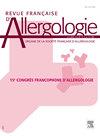The mechanism of astragaloside IV improving the regulation of miRNA-21 gene in allergic rhinitis in rat model
IF 0.3
4区 医学
引用次数: 0
Abstract
Objective
Taking miRNA-21 as a research target, the mechanism of acting as allergic rhinitis to improve allergic rhinitis is discussed.
Methods
Make allergic rhinitis models with protein ovalbumine (OVA). Thirty-six SD rats are randomly divided into blank groups, physiological saline model groups, high, medium, and low-dose Astragalus model groups and mometasone furoate model groups, each group of 6 animals. After the model is established, the Astragaloside IV, mometasone furoate, and normal saline intervention are established. After 2 weeks of treatment, the mechanism analysis is performed with technical testing such as ELISA, immunohistochemistry, and PCR.
Results
Compared with the blank group, the AR rats of the physiological saline group, the ECP protein content of the nasal mucosa tissue is significantly up (P < 0.05), indicating that the AR model is successful. Compared with the physiological saline group, the Western and high-dose ASIV group AR rats, the eCP protein content of the nasal mucosa tissue is significantly down (P < 0.05). Middle- and low-dose traditional Chinese medicines are not obvious on ECP. The horizontal blank groups of IL-4, IL-12 are significantly different from the biological saline group (P < 0.01). Compared with the physiological saline group, there is a significant decline in high-dose Chinese medicine and western medicine (P < 0.01). Compared with the blank group, the low-dose traditional ASIV group IL-4 is not as high as high, and the medium-dose Chinese medicine and mometasone furoate group are obvious (P < 0.01). The high and medium-dose ASIV group and the mometasone furoate group IL-4 concentration is significantly reduced (P > 0.05). The RT-PCR result shows that the amount of miRNA-21 after the modeling was successful declined significantly. The effect of Chinese medicine in low-dose groups is not ideal after treatment. After comparing high-dose Chinese medicine, mometasone furoate group and blank group, it has a certain effect on miRNA. The regression analysis of miRNA-21, IL-4, IL-12, and ECP shows the weak correlation between the three presents between the three.
Conclusion
The mechanism of astragalus metharin the treatment of allergic rhinitis may be that high-dose ASIV, like Western medicine, has the ability to up-regulate miRNA-21 to a certain extent. The dose–effect relationship between dose changes and miRNA-21 expression is weak, indicating that a higher dose of traditional Chinese medicine stimulation may be required to improve the effect on miRNA-21.
求助全文
约1分钟内获得全文
求助全文
来源期刊

Revue Francaise d Allergologie
Medicine-Immunology and Allergy
自引率
33.30%
发文量
349
期刊介绍:
La Revue Française d''Allergologie : un véritable forum pour faire connaître des travaux originaux et permettre la diffusion de l''information auprès de toutes les spécialités concernées par les pathologies allergiques. La Revue Française d''Allergologie (8 numéros par an) est au carrefour de nombreuses spécialités - dermatologie, pédiatrie, ORL, pneumologie, ophtalmologie, médecine interne - qui, toutes, ont à traiter des maladies allergiques. Les symptômes des allergies fondés sur des mécanismes communs sont le plus souvent associés et se succèdent chez un même patient. En forte progression depuis 20 ans, les maladies allergiques sont dans l''attente de perfectionnements et d''avancées thérapeutiques qui permettront aux nombreux patients qui en sont atteints de mieux vivre avec leurs allergies. La Revue Française d''Allergologie se veut donc un véritable forum de discussions et d''échanges entre tous les spécialistes confrontés aux pathologies
 求助内容:
求助内容: 应助结果提醒方式:
应助结果提醒方式:


